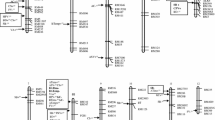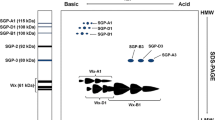Abstract
Gel consistency (GC) is a standard assay used in rice improvement programmes to determine whether rice cultivars/breeding lines of high amylose content are soft or firm textured when cooked. In this study, we show that sequence variation in exon 10 of the Waxy (Wx) gene associates with GC using RILs derived from parents with high amylose content that differ in GC. The association was validated using a diverse set of traditional varieties, selected on the basis of amylose content, from the generation challenge programme. Structural investigations to explain how the mutation leads to differences in GC showed a strong association between GC and the proportion of amylose that leaches. It was shown that cooked rices of hard GC do not change in hardness over 24 h, whereas rices of soft GC retrograde significantly over 24 h. This leads to the conclusion that the mutation on exon 10 of the Wx gene affects the proportion of amylose bound to amylopectin and the proportion able to leach, and these structural differences alter the composition of the gel, which affects the amount of time the gel takes to reach a final hardness. The SNP described here completes the set of markers required to genotype for the current traits of cooking quality, but selecting the allele for soft texture has the negative result of also selecting for retrogradation potential.



Similar content being viewed by others
References
Aoki N, Umemoto T, Yoshida S, Ishii T, Kamijima O, Matsukura U, Inouchi N (2006) Genetic analysis of long chain synthesis in rice amylopectin. Euphytica 151:225–234
Bao J (2002) Analysis of the relationship between Wx alleles and some starch quality parameters of rice (Oryza sativa L). Cereal Res Commun 30:397–402
Bao J, Corke H, He P, Zhu LH (2003) Analysis of quantitative trait loci for starch properties of rice based on an RIL population. Acta Bot Sin 45:986–994
Biliaderis CG, Zawistowski J (1990) Viscoelastic behavior of aging starch gels: effects of concentration, temperature, and starch hydrolysates on network properties. Cereal Chem 67:240–246
Biliaderis CG, Page CM, Maurice TJ, Juliano BO (1986) Thermal characterization of rice starches: a polymeric approach to phase transitions of granular starch. J Agric Food Chem 34:6–14
Cagampang GB, Perez CM, Juliano BO (1973) A gel consistency test for eating quality in rice. J Sci Food Agric 24:1589–1594
Cai XL, Wang ZY, Xing YY, Zhang J-L, Hong M-M (1998) Aberrant splicing of intron 1 leads to the heterogeneous 5′ UTR and decreased expression of waxy gene in rice cultivars of intermediate amylose content. Plant J 14:459–465
Champagne ET, Bett-Garber KL, Fitzgerald MA, Grimm C, Lea J, Ohtsubo K, Jongdee S, Xie L, Bassinello P, Resurreccion AP, Ahmad R, Habibi F, Reinke R (2010) Important sensory properties differentiating premium rice varieties. Rice 3:270–281
Chen M-H, Bergman C, Pinson S, Fjellstrom R (2008a) Waxy gene haplotypes: associations with apparent amylose content and the effect by the environment in an international rice germplasm collection. J Cereal Sci 47:536–545
Chen M-H, Bergman CJ, Pinson SRM, Fjellstrom RG (2008b) Waxy gene haplotypes: associations with pasting properties in an international rice germplasm collection. J Cereal Sci 48:781–788
Clark AH, Gidley MJ, Richardson RK, Ross-Murphy SB (1989) Rheological studies of aqueous amylose gels: the effect of chain length and concentration on gel modulus. Macromolecules 22:346–351
Cuevas R, Daygon V, Corpuz H, Waters DLE, Reinke RF, Fitzgerald MA (2010a) Melting the secrets of gelatinisation temperature. Funct Plant Biol 37:439–447
Cuevas R, Fitzgerald MA, Gilbert RG (2010b) Structural differences between hot-water-soluble and hot-water insoluble fractions of starch in waxy rice (Oryza sativa L). Carbohydr Polym 81:524–532
Debet MR, Gidley MJ (2007) Why do gelatinized starch granules not dissolve completely? Roles for amylose, protein, and lipid in granule “Ghost” integrity. J Agric Food Chem 55:4752–4760
Ellis HS, Ring SG (1985) A study of some factors influencing amylose gelation. Carbohydrate Polym 5:201–213
Genovese DB, Rao MA (2003) Role of starch granule characteristics (volume fraction, rigidity, and fractal dimension) on rheology of starch dispersions with and without amylose. Cereal Chem 80:350–355
Gidley MJ (1989) Molecular mechanisms underlying amylose aggregation and gelation. Macromolecules 22:351–358
Gidley MJ, Bulpin PV (1989) Aggregation of amylose in aqueous systems: the effect of chain length on phase behavior and aggregation kinetics. Macromolecules 22:341–346
He Y, Han Y, Jiang L, Xu C, Lu J, Xu M (2006) Functional analysis of starch-synthesis genes in determining rice eating and cooking qualities. Mol Breeding 18:277–290
Isshiki M, Morino K, Nakajima M, Okagaki RJ, Wessler SR, Izawa T, Shimamoto K (1998) A naturally occurring functional allele of the rice waxy locus has a GT to TT mutation at the 5′ splice site of the first intron. Plant J 15:133–138
Itturiaga LB, de Mishima BL, Anon MC (2010) A study of the retrogradation process in five argentine rice starches. LWT—Food Sci Technol 43:670–674
Juliano BO (1985) Criteria and tests for rice grain qualities. In: Juliano BO (ed) Rice chemistry and technology, 2nd edn. American Association of Cereal Chemists, Inc, MN, pp 43–524
Juliano BO, Cagampang GB, Cruz LJ, Santiago RG (1964) Some physicochemical properties of rice in Southeast Asia. J Series No 20:275–285
Lanceras JC, Huang ZL, Naivikul O, Vanavichit A, Ruanjaichon V, Tragoonrung S (2000) Mapping of genes for cooking and eating qualities in Thai jasmine rice (KDML105). DNA Res 7:93–101
Larkin PD, Park WD (2003) Association of waxy gene single nucleotide polymorphisms with starch characteristics in rice (Oryza sativa L). Mol Breeding 12:335–339
Li ZF, Wan JM, Xia JF, Yano M (2003) Mapping of quantitative trait loci controlling physico-chemical properties of rice grains (Oryza sativa L). Breeding Sci 53:209–215
Mikami I, Uwatoko N, Ikeda Y, Yamaguchi J, Hirano H, Suzuki Y, Sano Y (2008) Allelic diversification at the wx locus in landraces of Asian rice. Theor Appl Genet 116:979–989
Nguyen QD, Jensen CTB, Kristensen PG (1998) Experimental and modelling studies of the flow properties of maize and waxy maize starch pastes. Chem Eng J 70:165–171
Sano Y (1984) Differential regulation of Waxy gene expression in rice endosperm. Theor Appl Genet 68:467–473
Shapter FM, Eggler P, Lee LS, Henry RJ (2009) Variation in granule bound starch synthase I (GBSSI) loci amongst Australian wild cereal relatives (Poaceae). J Cereal Sci 49:4–11
Sodhi NS, Sasaki T, Lu Z-H, Kohyama K (2010) Phenomenological viscoelasticity of some rice starch gels. Food Hydrocolloid 24:512–517
Tang X, Khush GS, Juliano BO (1991) Genetics of gel consistency in rice (Oryza sativa L.). J Genet 70:69–78
Tian R, Jiang G-H, Shen L-H, Wang L-QH, Yu-Qing (2005) Mapping quantitative trait loci underlying the cooking and eating quality of rice using a DH population. Mol Breeding 15:117–124
Tsai M-L, Lii C-y (2000) Effect of hot-water-soluble components on the rheological properties of rice starch. Starch-Stärke 52:44–53
Wang ZY, Zheng F-Q, Shen G-Z, Gao J-P, Snustad DP, Li M-G, Zhang J-L, Hong M-M (1995) The amylose content in rice endosperm is related to the post-transcriptional regulation of the Waxy gene. Plant J 7:613–622
Wang LQ, Liu WJ, Xu Y, He YQ, Luo LJ, Xing YZ, Xu CG, Zhang Q (2007) Genetic basis of 17 traits and viscosity parameters characterizing the eating and cooking quality of rice grain. Theor Appl Genet 115:463–476
Ward RM, Gao Q, de Bruyn H, Gilbert RG, Fitzgerald MA (2006) Improved methods for the structural analysis of the amylose-rich fraction from rice flour. Biomacromolecules 7:866–876
Acknowledgments
NAT is grateful to ADB for her scholarship and to IRRI for enabling this work, and to Dr Genaleen Diaz and Dr Teresita Borromeo from UPLB for discussions. We thank Violeta Bartolome for assisting in the statistical analyses, the staff of the TT Chang GRC for growing the diverse set of traditional varieties, and the staff in the Plant Breeding, Genetics and Biochemistry Division of IRRI for samples of late generation breeding material for quality evaluation over the years. We thank IRRI for funding quality evaluation, and Teodoro Atienza, Leah Villanueva, Dennis Villegas, Juan Alzona and Romulo Aquino from GQNC quality evaluation program for processing the rice samples and measuring gel consistency on the materials.
Author information
Authors and Affiliations
Corresponding author
Additional information
Communicated by M. Wissuwa.
Electronic supplementary material
Below is the link to the electronic supplementary material.
Rights and permissions
About this article
Cite this article
Tran, N.A., Daygon, V.D., Resurreccion, A.P. et al. A single nucleotide polymorphism in the Waxy gene explains a significant component of gel consistency. Theor Appl Genet 123, 519–525 (2011). https://doi.org/10.1007/s00122-011-1604-x
Received:
Accepted:
Published:
Issue Date:
DOI: https://doi.org/10.1007/s00122-011-1604-x




